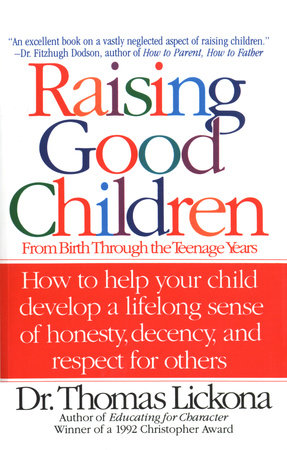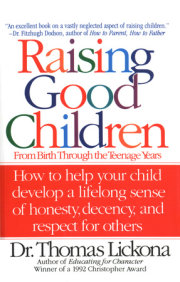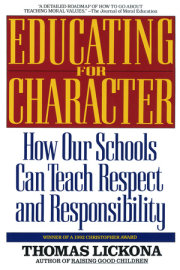CHAPTER 1
RAISING GOOD CHILDREN
Of all the tasks of parenting, few are as important as raising good children.
That’s because morality, or basic goodness, lies at the heart of what it means to be human.
As parents, we may want many things for our children. We may want them to bring home good grades, do well at sports, or have lots of friends. But they are no less persons, no less human, if they do not possess these qualities.
It’s a different matter, however, if our children are not good and decent people. In that case, they do not stand tall as persons. Their humanity is diminished.
But what does it mean to “be good”? Is a good child one who never questions when told what to do? Or does healthy obedience include moral reasoning—the ability to understand in your own conscience why some things are right and others wrong?
Think for a minute about what you want for your children when you want them to be good.
You want them to be fair and honest and trustworthy.
You want them to respect the rights of others. You want them to respect legitimate authority, rules, and laws.
You want them to be responsible for their own behavior. You want them to feel a decent measure of concern for their fellow human beings.
You want them to be able to stand on their own feet and resist pressure to go with the crowd.
You want them to be capable of generosity and love.
All of these things are part of being a good person. And I think all parents who are concerned about raising good children want their children to have these qualities.
WHAT CAN PARENTS DO?
What does it take to raise a good child?
There’s no doubt in my mind that it takes more from parents than it ever did before. In the old days, Mom and Dad were part of a bigger team. Home, school, and church all taught the same basic values and pulled together to keep kids on the straight and narrow. That’s certainly far less true today. In the old days, kids had many “parents.” If your own mother or father didn’t catch you when you were up to no good, your grandmother did, or your Uncle Nick, or the lady next door. As one mother says, “In those days, everybody supervised everybody’s kids. Now a lot of people don’t even supervise their own.” It wasn’t long ago when a mother and a father had at least each other to share the task of caring for kids and guiding their development. Now, with the rapid rise in single-parent families, the whole job often falls on one parent’s shoulders.
Parents not only have less help than they used to, but they’re also up against a lot more. They face a social environment that is actively hostile to many of the values they would like to teach their children. TV and movies present violence, law-breaking, and casual sex as standard human behavior. The peer group is an ever more powerful shaper of kids’ thinking and behavior, and it often teaches values that go directly against what we want our children to learn. A study by Cornell University’s Dr. Urie Bronfenbrenner found that American children were more likely to break a rule or law if they thought their peers would know about it. Says a father,
“I find a black and white contrast between my values and the values kids get from their peer group. I was brought up on self-discipline and self-denial. Be a good student, and you’ll get a good job. Be a good person, and you’ll go to heaven. To today’s peer group, whatever feels good is cool. Getting in trouble is great. Their ethic is immediate satisfaction. Pleasure now.”
Says a mother of two teenage girls,
“The kids are forever saying, ‘Everybody’s doing it.’ ‘Everybody goes to parties where there’s drinking.’ ‘Everybody goes to R movies.’ They keep it up. After a while, it starts to wear you down.”
Researchers confirm what parents fear: kids at every grade level are more dependent on peers than they used to be.
Other parents are part of the problem. Not everybody makes raising good kids a high priority. Not everybody wants to invest the time and effort it takes to monitor what kids are doing and guide their thinking and actions. Says one father, “I hate to admit it, but frankly, it’s too much of a hassle to keep after the kids. I don’t have the energy for it.” Not everybody takes the trouble to discipline their kids or say no to them when they want to go to unsupervised parties or drink before they’re of age. Not everybody sets a good example for their children. Said a high school principal to the mother of a failing student, a boy who was known to be a heavy marijuana user: “Your son is smoking a lot more dope than is good for him.” Replied the mother: “He gets better stuff than we do.”
THE NEW MORALITY
The “new morality” obviously isn’t limited to our children’s peer group. It runs through much of the adult culture as well. It says “Look out for number one” and “Do as you damn well please.” It came partly out of the sixties, which advanced individual human rights but also fostered disrespect for law and authority and ballyhooed the idea that people should “do their own thing.” It came partly out of the seventies, which exposed corruption in all walks of life and left people with the feeling that everybody else is out for himself, so why not me? The old morality, with roots in religion, speaks of respect, service to others, sacrifice, resistance to temptation, and moderation in the pursuit of pleasure. The new morality celebrates self-centeredness and self-indulgence. Grab what you can get, because you only go around once.
In view of all this, it’s not surprising that so many kids are in trouble. True, there are a lot of good kids who aren’t in trouble, and we can be thankful for that. But there are alarming signs of a widespread decline of morality among young people. Consider the following:
• Juvenile crime. More than half of all serious crimes in the United States are now committed by youths 10 to 17 years of age. Juvenile delinquency is increasing so fast that one of every nine kids will appear in court by age 18. And studies by the National Council on Crime and Delinquency show that criminal acts are as common among middle-class kids as they are among those from low-income homes.
• Disrespect for authority. Teachers everywhere agree that students of all ages have far less respect for authority than they once had. Children and teenagers defy their teachers, even swear at them. Says one substitute teacher who has worked for 10 years in an affluent suburb: “Every obscene word you can possibly think of has come out of the mouths of elementary-school students. And these aren’t ‘bad’ schools.
• Violence and vandalism in the schools. In 1975 a U.S. Senate subcommittee determined that the annual cost of vandalism and theft in American schools was $600 million. That’s equivalent to the annual national expenditure on school textbooks. And violence continues to mount: each year more than 100,000 teachers and hundreds of thousands of students are assaulted in school.
• Children’s cruelty to each other. Says a veteran elementary-school principal: “We’re seeing more just plain meanness. On the playground kids don’t seem to play like they used to; they rove around in gangs. They’re quick to identify the weak ones, kids on the fringe, kids who don’t wear the right sneakers or jeans. They go after them, taunt them; there’s a vicious edge to it. Some kids are literally devastated. We’ve tried to stop it, but we haven’t been very successful.”
• Cheating. Says a 15-year-old girl: “All my friends are cheating on tests and getting good grades as a result.” In one high school survey 95 percent of juniors and seniors admitted cheating.2 At the college level, according to a survey of research by psychologist Roger Burton, 50 percent to 80 percent of students, given the chance, will cheat on a test.3 Many colleges and universities have had to abandon honor codes because of the frequency of violations. In some cases, students have been found bribing custodians to get copies of an exam and then selling them to their fellow students. Explains one student at a major university: “Cheating is a way of life here.”
• Self-centeredness. A 1981 Carnegie Commission report on American colleges and universities found a rising “meism” (a combination of individualism, cynicism, and materialism) among today’s college students.4 “The students I teach,” says a college ethics professor, “seem to be concerned about one thing: their career. It’s hard to find signs of social conscience.” Says a Princeton University student quoted in the Carnegie report: “College students today have no collective orientation. We are out for ourselves.”
• Drugs and drinking. Drug abuse and excessive drinking may not seem at first glance like moral problems, but they are. Kids who are into drugs risk ruining their own bodies, and that’s a violation of respect for themselves. They’re also usually breaking the law, either by possessing the drug or stealing to support their habit. Likewise, kids who drink to excess risk making a mess of their own lives, and when they get behind a wheel, they endanger the lives of others. There’s hardly a community that doesn’t face the problems of teenage drug abuse and drinking. The number of teenage alcoholics is estimated to be 2½ million. During the 1970s, the number of 12- to 17-year-olds experimenting with marijuana and cocaine doubled. Often it starts even younger. Says a mother of two boys in a white-collar town: “The elementary schools in this community are full of drugs. Our kids were into it before we knew what was happening.”
• Teenage sex. The age at which teenagers begin to have sexual relations gets younger all the time. One in five has had intercourse by 15. Teenagers account for 25 percent of the 1 million reported cases of gonorrhea each year. Half of all illegitimate babies in this country are now born to teenage mothers.
Copyright © 2012 by Thomas Lickona. All rights reserved. No part of this excerpt may be reproduced or reprinted without permission in writing from the publisher.






